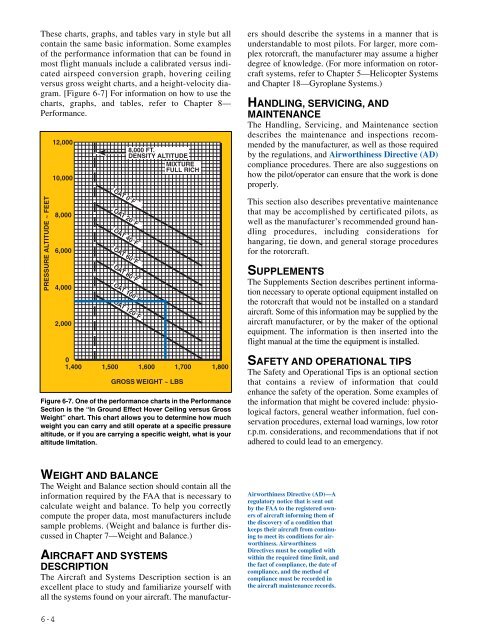Rotorcraft Flying Handbook, FAA-H-8083-21
Rotorcraft Flying Handbook, FAA-H-8083-21
Rotorcraft Flying Handbook, FAA-H-8083-21
Create successful ePaper yourself
Turn your PDF publications into a flip-book with our unique Google optimized e-Paper software.
These charts, graphs, and tables vary in style but all<br />
contain the same basic information. Some examples<br />
of the performance information that can be found in<br />
most flight manuals include a calibrated versus indicated<br />
airspeed conversion graph, hovering ceiling<br />
versus gross weight charts, and a height-velocity diagram.<br />
[Figure 6-7] For information on how to use the<br />
charts, graphs, and tables, refer to Chapter 8—<br />
Performance.<br />
12,000<br />
10,000<br />
8,000 FT.<br />
DENSITY ALTITUDE<br />
MIXTURE<br />
FULL RICH<br />
ers should describe the systems in a manner that is<br />
understandable to most pilots. For larger, more complex<br />
rotorcraft, the manufacturer may assume a higher<br />
degree of knowledge. (For more information on rotorcraft<br />
systems, refer to Chapter 5—Helicopter Systems<br />
and Chapter 18—Gyroplane Systems.)<br />
HANDLING, SERVICING, AND<br />
MAINTENANCE<br />
The Handling, Servicing, and Maintenance section<br />
describes the maintenance and inspections recommended<br />
by the manufacturer, as well as those required<br />
by the regulations, and Airworthiness Directive (AD)<br />
compliance procedures. There are also suggestions on<br />
how the pilot/operator can ensure that the work is done<br />
properly.<br />
PRESSURE ALTITUDE ~ FEET<br />
8,000<br />
6,000<br />
4,000<br />
2,000<br />
OAT 0°F<br />
OAT 20°F<br />
OAT 40°F<br />
OAT 60°F<br />
OAT 80°F<br />
OAT 100°F<br />
OAT 120°F<br />
This section also describes preventative maintenance<br />
that may be accomplished by certificated pilots, as<br />
well as the manufacturer’s recommended ground handling<br />
procedures, including considerations for<br />
hangaring, tie down, and general storage procedures<br />
for the rotorcraft.<br />
SUPPLEMENTS<br />
The Supplements Section describes pertinent information<br />
necessary to operate optional equipment installed on<br />
the rotorcraft that would not be installed on a standard<br />
aircraft. Some of this information may be supplied by the<br />
aircraft manufacturer, or by the maker of the optional<br />
equipment. The information is then inserted into the<br />
flight manual at the time the equipment is installed.<br />
0<br />
1,400<br />
1,500<br />
1,600 1,700 1,800<br />
GROSS WEIGHT ~ LBS<br />
Figure 6-7. One of the performance charts in the Performance<br />
Section is the “In Ground Effect Hover Ceiling versus Gross<br />
Weight” chart. This chart allows you to determine how much<br />
weight you can carry and still operate at a specific pressure<br />
altitude, or if you are carrying a specific weight, what is your<br />
altitude limitation.<br />
SAFETY AND OPERATIONAL TIPS<br />
The Safety and Operational Tips is an optional section<br />
that contains a review of information that could<br />
enhance the safety of the operation. Some examples of<br />
the information that might be covered include: physiological<br />
factors, general weather information, fuel conservation<br />
procedures, external load warnings, low rotor<br />
r.p.m. considerations, and recommendations that if not<br />
adhered to could lead to an emergency.<br />
WEIGHT AND BALANCE<br />
The Weight and Balance section should contain all the<br />
information required by the <strong>FAA</strong> that is necessary to<br />
calculate weight and balance. To help you correctly<br />
compute the proper data, most manufacturers include<br />
sample problems. (Weight and balance is further discussed<br />
in Chapter 7—Weight and Balance.)<br />
AIRCRAFT AND SYSTEMS<br />
DESCRIPTION<br />
The Aircraft and Systems Description section is an<br />
excellent place to study and familiarize yourself with<br />
all the systems found on your aircraft. The manufactur-<br />
Airworthiness Directive (AD)—A<br />
regulatory notice that is sent out<br />
by the <strong>FAA</strong> to the registered owners<br />
of aircraft informing them of<br />
the discovery of a condition that<br />
keeps their aircraft from continuing<br />
to meet its conditions for airworthiness.<br />
Airworthiness<br />
Directives must be complied with<br />
within the required time limit, and<br />
the fact of compliance, the date of<br />
compliance, and the method of<br />
compliance must be recorded in<br />
the aircraft maintenance records.<br />
6-4

















